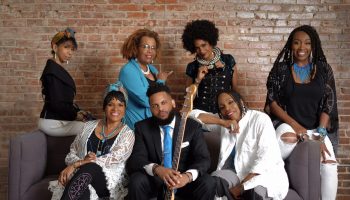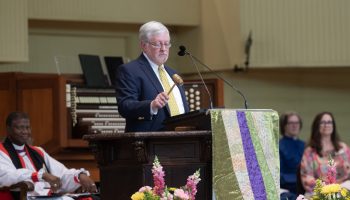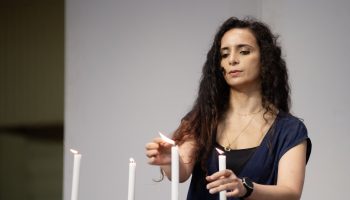
Susie Anderson
Staff Writer
In a time in which the existence of art itself feels threatened, former president of the Kennedy Center Deborah Rutter has not lost her faith in creativity powered by community.
“The artist will always prevail,” Rutter said.
Bringing nearly five decades of experience as a nonprofit executive to her lecture, Rutter closed out Chautauqua Lecture Series’ Week Three’s theme “Art in Action: Building Community Through the Arts” at 10:45 a.m. Friday on the Amphitheater stage.
Rutter was the first female president of the Kennedy Center, serving from 2014 to 2025. Her career began at the Los Angeles Philharmonic before working at institutions such as the Chicago Symphony Orchestra and the Seattle Symphony Orchestra. In 2014, Rutter was elected president of the Kennedy Center, where she expanded artistic and educational programming, collaborated with National Institutes of Health and the National Endowment for the Arts and established Hip Hop Culture Council to create new pathways and deepen knowledge of hip-hop.
Rutter discussed the state of the arts in America and her work at the Kennedy Center, followed by a discussion with Chautauqua’s Senior Vice President and Chief Program Officer Deborah Sunya Moore about that work.
Rutter walked onto the Amp stage to a standing ovation from Chautauquans and began her lecture with gratitude.
“Thank you for this invitation. It is our first time here. I’m embarrassed by that. But I promise it will not be our last,” Rutter said.
She opened the lecture with a video titled “Together for the Arts,” highlighting the Kennedy Center’s values of creativity, expression and commitment to community. After the video, Rutter shared that the institution was created under President Dwight Eisenhower, who commissioned the creation of the National Culture Center for the United States in 1958.
“It was only at the death of President Kennedy that it became a living memorial,” Rutter said.
After John F. Kennedy’s death, the center began receiving funds from the federal government, private sources and international donations. Rutter said that in her nearly five decades of nonprofit work, she found her work at the Kennedy Center to be the most rewarding.
“It was the best job imaginable because it was our mission to facilitate transformative experiences that you saw there for millions of patrons who attended the 2,000 performances we produced or presented each year at the Kennedy Center,” Rutter said.
Operating with both political parties and a massive executive board, Rutter left her position with confidence in the work she had done.
“Because of their support and what together we were able to achieve, I can confidently assert that when I left the Kennedy Center for the last time on Feb. 12, it was more vibrant and better positioned for growth and impact than at any time since its nationally celebrated opening in 1971,” Rutter said.
Reflecting on the 2024 calendar year at the Kennedy Center, Rutter showed a video from the Kennedy Center Honors Weekend, highlighting the variety and beauty of performances and events held throughout 2024. Clips ranged from Kevin Hart receiving the Mark Twain Prize, to the collaboration of author Mo Willems and the National Symphony Orchestra in a performance titled “Mo @ the NSO.”
In collaboration with Yo-Yo Ma nearly 20 years ago, Rutter established the idea of “citizen artistry,” or a call to action for individuals to create and support art within their own communities, beyond the beautiful venues and concert halls.
“I would propose to you that a performance of a trio in a senior center, a lone guitar-playing singer in a hospital or an ensemble in a homeless shelter are just as impactful, and in some ways, more meaningful and memorable to those audiences than the very glorious concert heard here last night,” she said.
In a time when the neediest lack the most powerful medicine of love, beauty and attention, Rutter said the challenge facing arts administrators is how to expand the audiences and excite interests.
“It is our responsibility and obligation to shine a light on new talent, and at times, to point the way,” she said. “In a very real way, it’s the art of what we do, always striving to achieve the right balance, sometimes serving entrenched preferences while ensuring that our programming is also evolving and vibrant and contemporary to our time.”
Part of that evolution is creating new programming in the Kennedy Center. Rutter collaborated with musician and rapper Q-Tip to add hip-hop into the center’s programming. Expanding the scope of programming and inviting new audiences into the Kennedy Center, Rutter shared that she received some feedback.
“We always say we want some of those new audiences to come and see what we love,” she said. “And I had a conversation with a board member of the opera saying, ‘I don’t understand why you did that. Why are you bringing this in? We just need them to come to see the opera.’ And I said, ‘Well guess what? If you don’t know what they like and aren’t prepared to know what they do, then how will they feel comfortable coming to what you like?’ ”
Rutter emphasized the importance of defending artists and creating space for varied audiences. Finding the balance between maintaining longtime friends while also filling auditorium seats every night, Rutter said, is a challenge.
“Let’s be honest, sometimes it doesn’t work. And sometimes it does,” she said. “When it does, it’s magical. Marvelous things happen and justifies all the devotion, toil and pursuit. But when it doesn’t, it’s disappointing. And yes, sometimes painful. But we are all better if we endeavor to get it right, to serve the artists and their art and to connect what they offer in ways that provide audiences insight, meaning and a sense of greater purpose.”
Addressing the current state of the nation, Rutter said that now, more than ever, is the time to assert the benefit of art and culture to improve society. She acknowledged the harm in trying to place values or restrictions on art.
“I continue to believe that this present trend of labeling certain artistic expressions as counter to our national values … will, no doubt, fail. Time, as we have seen, has a way of righting wrongs. And fortunately for us, artistic talent is typically granted in a similar proportion to personal courage.”
Rutter said the determination of any government to determine what is “acceptable artistic expression” is futile.
“The artist will always create, always enlighten, always reshape our perspectives, how we see the world and our role in it, challenging our assumptions, attitudes, cultural bias, and even at times, whole social movements. Quite simply, the artist holds a mirror to who we are as a people and nation and compels us to be and do better,” Rutter said.
Rutter reinforced the sentiment that there is no better time than now to engage in communities and lean into the invaluable benefits of the arts. She offered advice to artists and audiences alike.
“To the artist, I say continue to do your work fearlessly and with integrity. Assert and express your art in those places wherever you feel safe, welcome, and supported,” she said. “… To audiences and those of us who work and support the artists, I say trust the artists. Follow the artists. Continue to support the artists wherever they feel welcome, supported, empowered and unencumbered to share their art and express their creative talent.”
Concluding her lecture, Rutter echoed a message from John F. Kennedy’s address at Amherst College one month before his death.
“We must never forget that art is not a form of propaganda, it is a form of truth. So for our sake in this time, and for the sake of future generations, we will need to come together. We must safeguard and champion the artist, as well as our collective and individual freedoms to revel in the experiences they make possible. For our sanity, for our humanity, we must do this,” Kennedy said.
Rutter then sat down with Moore to discuss the topics covered in her lecture. Addressing the balance between heritage and innovation, Rutter shared that she felt pressure from programming 2,000 performances a year for the center. She described the difficulty of working with deadlines and meeting sales quotients.
“You know what I mean by this,” Rutter said to Moore.
“I have no idea,” Moore replied with a laugh.
On convincing the rest of the organization to take risks on new artists in pursuit of profit, Rutter said that it was a matter of looking into innovation to expand audiences. In her experience, Rutter found success in pursuing new frontiers.
“What’s really interesting, though, is that almost all of the new ventures that we started on proved to be net financially positive to the Kennedy Center, not negative,” she said. “So by making wise and careful decisions, you can expand your programming and keep your organization strong.”
Rutter expanded more than audiences in her time as president. She initiated the first-ever physical expansion of the center, called The REACH, which began with her transforming the pre-existing designs for the expansion.
“They handed me a piece of paper with nine spaces and room dimensions,” she said. “I said, ‘OK, but what will happen in the rooms?’ And they said, ‘Oh, that’s for you to figure out.’ ”
In response, Rutter turned to the staff of artists, educators and the production team to determine what the Kennedy Center lacked and what they needed in order to do their jobs in the best possible way.
“We conceived of a place that would be the manifestation of our beliefs that arts could and should be more immersive, participatory and transparent to audiences, and that we would have some uniquely designed spaces for teaching and do-it-yourself arts workshops,” she said. “And that’s what we created.”
When Moore asked how individuals might develop that inclusive programming without a physical space, Rutter reinforced the importance of individuals working in their own communities.
“This does not have to be in these pristine, beautiful, site-specific venues. It can happen and needs to happen everywhere,” Rutter said.
Tackling the polarization of artists today, Rutter shared anecdotes about artists who resigned after Rutter’s termination and others who continued to finish out their year and support their teams before stepping back.
“This is not a criticism of the work of the National Symphony Orchestra, the Washington National Opera or others who stay and continue to do their work,” she said. “They are making it in this way and doing it in the way that I feel is important. And I stand by that. So it’s important for us all to continue to do that and understand the artists.”
In a concluding question about the value of joy in art, Rutter said that not everyone has the same tastes, but it is important to create a balance between art that individuals enjoy and art that challenges them.
“People will experience (art) differently. And it’s our job to provide a little bit of everything. I doubt that people feel challenged by The Nutcracker. But there’s a lot of joy in The Nutcracker. So we need to always have some Nutcracker in there and have the right kind of balance.”
“No one is taking away The Nutcracker,” Moore said.
“Never,” Rutter said.




